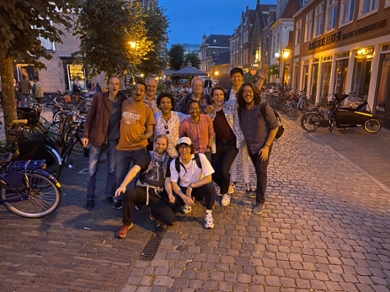
Consensus, bias and polarisation: How mathematicians study opinions
How do opinions form and change in large groups of people? That's not just a sociological question, it's a mathematical one. PhD candidate Federico Capannoli studied opinion dynamics. He defended his thesis on November 19.
‘Many processes in real life are too complex to analyse them exactly as they are,’ says Capannoli. ‘But we can represent them with mathematical models.’ He is talking about complex networks. Opinion dynamics in groups of people are one example, but the way cells move in biological materials or how diseases spread are others. Surprisingly, they can all be described with similar models.
Modelling the world as a network of connected dots
The PhD candidate did his Master's in Padova and came to Leiden for his PhD. ‘My supervisor recommended the probabilistic research group in Leiden and it did not disappoint. There is real expertise in this field here and I always felt like I was welcome.’
Capannoli makes models to understand how quickly opinions in large groups of people evolve. To imagine this, picture each person as a dot. The person's opinion is represented by the colour of the dot. And if two people are friends, then their dots are connected with a line. This is the basic shape of a complex network.

Elections as a complex network
‘The recent elections are a good example,’ explains Capannoli. ‘Everyone has a preferred political party, that’s the colour of their dot. But in the weeks coming up to the elections, people talk and influence each other.’ In other words, the colours of the dots change over time.
In Capannoli’s theoretical model, at some point everyone shares the same opinion. He studies how long it takes to reach this consensus and what characteristics of the network affect it. ‘The time to reach consensus is proportional to the number of people. The number of connections between people also matter. If only a handful of people is very well-connected to most of the other individuals while the vast majority has few connections, then you still reach consensus much faster.’
Back to the election example: this means that one person with a large reach, for example on social media, has a big influence on everyone’s opinion.

Influencing opinions
He also looked at the presence of bias, like politicians trying to influence swing voters during their campaign. ‘We can model this. If two people in the network talk, there is a chance that one of them blindly adopts a biased opinion. Due to propaganda, for example,’ Capannoli says. ‘If this bias is high, the time to reach consensus is cut drastically. But if it is small, it doesn’t affect the consensus time much.’
When friendships break and groups polarise
Of course, reality is more complicated. ‘If two people have different opinions, their friendship could end. Or new friendships form when two strangers talk,’ says Capannoli. So not only the colours of each dot can change, but also the lines connecting them.
He explains that this co-evolution of opinions and friendships is very difficult to study. Leiden is at the forefront of this area of research, especially in Frank den Hollander and Rajat Subhra Hazra’s group. With this co-evolution, polarisation of opinions can happen. The network falls apart into disconnected groups that don’t talk to each other. ‘It's quite scary if you think about it,’ reflects the PhD candidate. ‘And also a good reminder of why social media can be so dangerous. It keeps you in your bubble. It's important to interact with other points of view.’
